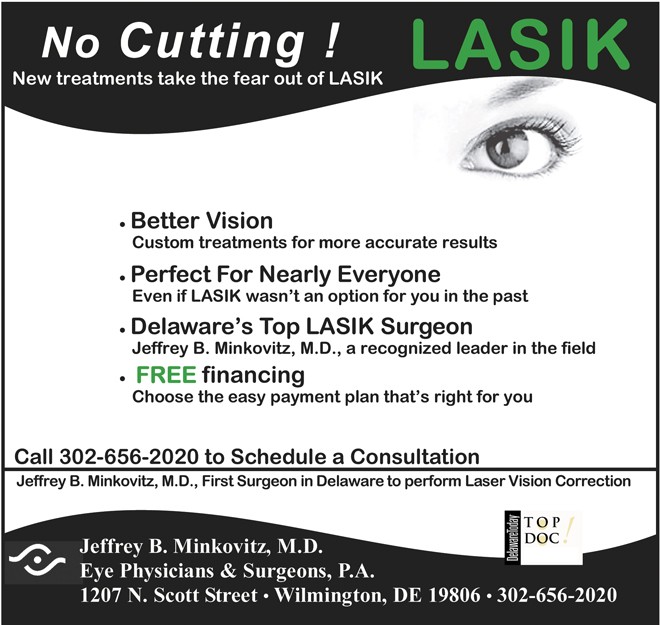Laser Vision Correction:
LASIK vs Advanced Surface Ablation; Safety And Results Dictate My Guidance
 By Jeffrey B. Minkovitz, M.D.
By Jeffrey B. Minkovitz, M.D.
Laser vision correction, performed to reduce dependence upon glasses, affords patients the opportunity to dramatically improve their lives. As with many ophthalmology procedures, it also affords surgeons the privilege to provide impactful changes. With privilege comes responsibility to be prudent about risks, benefits, and patients’ interests and to use surgical skills and medical experience to guide patients appropriately.
Neither celebrity endorsements, latest trends,
nor advertisements of corporate medical chains should supplant thoughtful patient centered conversation and evaluation by responsible
medical professionals.
Laser Vision Correction has experienced remarkable advances in technology since approved in 1995. Expansion in treatment parameters allowing stronger corrections (nearsightedness, farsightedness, astigmatism) has made laser vision correction an option for many patients originally deemed ineligible. Technology advances affording greater accuracy, faster recovery, and less risk, have converged into a modern, accessible procedure with dramatic results.
Involved in laser vision correction since my ophthalmology training and an investigator in early studies leading to FDA approval, I participated in many of these advancements. Most have been of obvious benefit to patients. However, some have addressed patients’ desire for rapid results and convenience (admittedly not inconsequential) while also increasing risk. Eager to provide my patients with the latest advances, I oftentimes adopted new technology early. Nevertheless, I have always been guided by my responsibility to evaluate safety and efficacy, to “put to work” my experience and judgment and to determine whether a procedure, especially if new, meets the test of safety.
Laser vision correction was first approved in 1995 as PRK (Photo Refractive Keratectomy). Safer and more accurate than its predecessor RK (Radial Keratotomy), it was hampered by discomfort and slow recovery. LASIK (Laser-Assisted in-Situ Keratomileusis) was introduced several years later, combining creation of a corneal flap and laser. Pain was virtually eliminated and great results were achieved more quickly, addressing patients’ main objections. Unfortunately, flap creation also adds an element of risk, and advantages must be weighed against disadvantages.
Advanced Surface Ablation is a hybrid of the original PRK procedure and the subsequent LASIK procedure. Using the laser to reshape the cornea, no flap is created, but rather superficial surface cells are removed or loosened (just before laser is applied), matching or exceeding the accuracy of LASIK while avoiding safety concerns of cutting flaps. While surface treatment is necessary for certain cases, such as thin corneas, dry eyes and active lifestyles (military, police, sports) in which LASIK flaps may be contraindicated altogether, Advanced Surface Ablation can be used for all laser vision correction patients to provide a safer, accurate procedure. Surface treatment creates less thinning (therefore stronger corneas with less risk of ectasia or injury in active patients), avoids flap complications including wrinkles, dislocations, debris or inflammation under the flap, and less risk of dry eye. In fact, the vast majority of LASIK related complications are associated with the corneal flap and can be eliminated by performing Advanced Surface Ablation instead. Furthermore, some recent studies suggest surface treatment may better take advantage of newer wavefront treatments designed to reduce aberrations and optimize results.
Having performed RK, PRK and LASIK, I now recommend Advanced Surface Ablation for all laser vision correction patients. I strongly believe this form of laser vision correction provides the best balance between safety and convenience, while providing the absolute best visual results.
Jeffrey Minkovitz, MD is an ophthalmologist with Eye Physicians and Surgeons in Wilmington, Delaware. Dr. Minkovitz specializes in cataract and refractive surgery, and is one of only a few Delaware surgeons specially trained in corneal transplantation. He completed a cornea and refractive surgery fellowship at the renowned Wilmer Eye Institute of Johns Hopkins. Previously, he graduated magna cum-laude from Harvard, earned his medical degree from the University of Massachusetts, completed internship at Harvard’s Mt. Auburn Hospital, and served his ophthalmology residency at Washington University.
Dr. Minkovitz participated in the early research on Excimer Laser refractive surgery, and has offered this procedure to Delawareans since FDA approval in 1996, before Delaware had its own laser. These early pioneering individuals travelled to Wilmer Institute with Dr. Minkovitz, where he maintained his teaching and clinical appointment. In addition to introducing laser vision correction to Delaware, he also introduced NearVision CK to eliminate reading glasses, DSAEK (a newer, less invasive type of corneal transplant) and most recently the newest advance: laser cataract surgery.
Dr. Minkovitz is a co-founder of the Center for Advanced Surgical Arts and serves on its medical advisory board. He is also on active staff at Christiana Care. While on staff of Wilmer at Johns Hopkins University, Dr. Minkovitz received the Outstanding Teacher award. He was also named Top Doc in ophthalmology by Delaware Today Magazine six consecutive years, and has been an invited instructor at American Academy of Ophthalmology Annual Meetings.
For further information or to schedule an appointment please call 302-656-2020 extension 1.
“New advances in the CK technique, called light touch, produce more effective and predictable results.”
CK® Testimonial…
It finally occurred to me what has been missing during the last 2 days. Since Richard’s surgery, he isn’t complaining about his inability to read something on the fly without searching for his glasses. He wired 6 recessed lights (NO GLASSES), he read the Sunday paper sections A & B and menus (NO GLASSES), and is using the computer (NO GLASSES). I suppose for Richard, needing to look for glasses when he wanted to see something, has been the hardest adjustment of becoming older. His dependence was so gradual that I never related to why he would get so angry over needing them. My house has been quieter. I now have 2 less things to do everyday: find the glasses and make sure they were clean!


